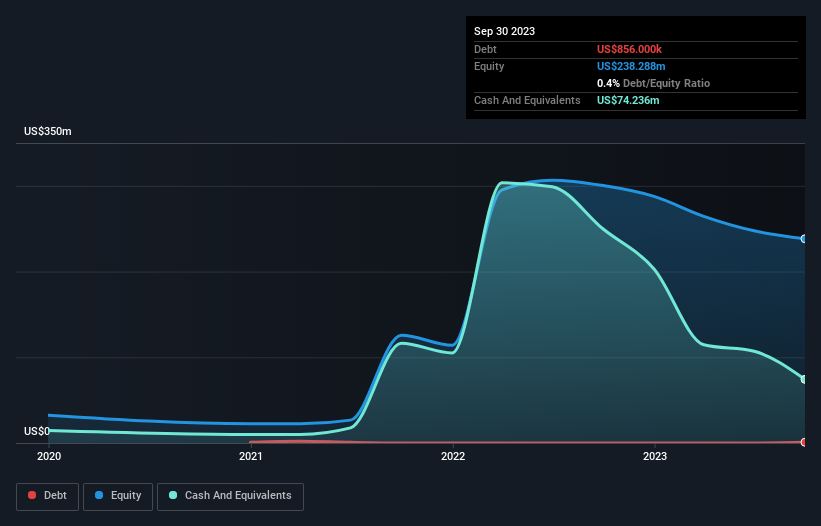- United States
- /
- Electrical
- /
- NYSE:NRGV
Companies Like Energy Vault Holdings (NYSE:NRGV) Could Be Quite Risky

Just because a business does not make any money, does not mean that the stock will go down. For example, although Amazon.com made losses for many years after listing, if you had bought and held the shares since 1999, you would have made a fortune. But while history lauds those rare successes, those that fail are often forgotten; who remembers Pets.com?
So should Energy Vault Holdings (NYSE:NRGV) shareholders be worried about its cash burn? For the purpose of this article, we'll define cash burn as the amount of cash the company is spending each year to fund its growth (also called its negative free cash flow). We'll start by comparing its cash burn with its cash reserves in order to calculate its cash runway.
See our latest analysis for Energy Vault Holdings
How Long Is Energy Vault Holdings' Cash Runway?
A company's cash runway is calculated by dividing its cash hoard by its cash burn. As at September 2023, Energy Vault Holdings had cash of US$74m and such minimal debt that we can ignore it for the purposes of this analysis. Looking at the last year, the company burnt through US$120m. So it had a cash runway of approximately 7 months from September 2023. That's quite a short cash runway, indicating the company must either reduce its annual cash burn or replenish its cash. The image below shows how its cash balance has been changing over the last few years.

How Well Is Energy Vault Holdings Growing?
Notably, Energy Vault Holdings actually ramped up its cash burn very hard and fast in the last year, by 113%, signifying heavy investment in the business. But shareholders are no doubt taking some confidence from the rockstar revenue growth of 610% during that same year. Considering the factors above, the company doesn’t fare badly when it comes to assessing how it is changing over time. While the past is always worth studying, it is the future that matters most of all. So you might want to take a peek at how much the company is expected to grow in the next few years.
Can Energy Vault Holdings Raise More Cash Easily?
Since Energy Vault Holdings has been boosting its cash burn, the market will likely be considering how it can raise more cash if need be. Issuing new shares, or taking on debt, are the most common ways for a listed company to raise more money for its business. One of the main advantages held by publicly listed companies is that they can sell shares to investors to raise cash and fund growth. We can compare a company's cash burn to its market capitalisation to get a sense for how many new shares a company would have to issue to fund one year's operations.
Energy Vault Holdings has a market capitalisation of US$195m and burnt through US$120m last year, which is 62% of the company's market value. That's very high expenditure relative to the company's size, suggesting it is an extremely high risk stock.
How Risky Is Energy Vault Holdings' Cash Burn Situation?
Even though its cash burn relative to its market cap makes us a little nervous, we are compelled to mention that we thought Energy Vault Holdings' revenue growth was relatively promising. After looking at that range of measures, we think shareholders should be extremely attentive to how the company is using its cash, as the cash burn makes us uncomfortable. Separately, we looked at different risks affecting the company and spotted 4 warning signs for Energy Vault Holdings (of which 1 is a bit unpleasant!) you should know about.
If you would prefer to check out another company with better fundamentals, then do not miss this free list of interesting companies, that have HIGH return on equity and low debt or this list of stocks which are all forecast to grow.
Valuation is complex, but we're here to simplify it.
Discover if Energy Vault Holdings might be undervalued or overvalued with our detailed analysis, featuring fair value estimates, potential risks, dividends, insider trades, and its financial condition.
Access Free AnalysisHave feedback on this article? Concerned about the content? Get in touch with us directly. Alternatively, email editorial-team (at) simplywallst.com.
This article by Simply Wall St is general in nature. We provide commentary based on historical data and analyst forecasts only using an unbiased methodology and our articles are not intended to be financial advice. It does not constitute a recommendation to buy or sell any stock, and does not take account of your objectives, or your financial situation. We aim to bring you long-term focused analysis driven by fundamental data. Note that our analysis may not factor in the latest price-sensitive company announcements or qualitative material. Simply Wall St has no position in any stocks mentioned.
About NYSE:NRGV
Energy Vault Holdings
Develops and deploys utility-scale energy storage solutions.
Slight with mediocre balance sheet.
Similar Companies
Market Insights
Community Narratives



